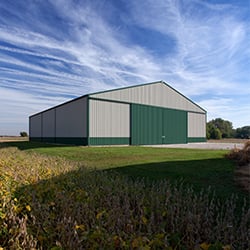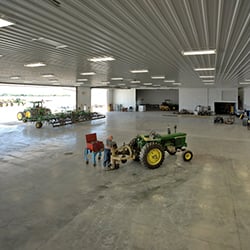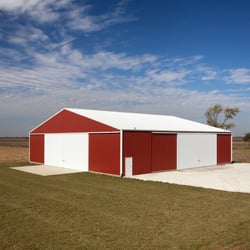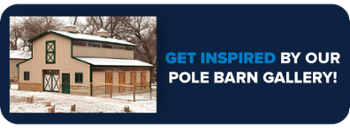Posts | Building Tips | Cost
4 Leasing Options to Consider for Your Farm Building
Angie graduated from Indiana State University with a Bachelor of Science in Interior Design. Prior to joining the FBi team, Angie was a kitchen and bath sales consultant in Lafayette, IN. In 2012, she started with FBi as the Inside Sales/Marketing Assistant. Today she holds the role of Sr. Marketing and Inside Sales Manager. Angie grew up in a farming community and has always enjoyed helping her family on the farm. A past 10-year 4-H Member, her passion for livestock pursued her to take a career in the agriculture field. She and her husband live in Northwest Indiana with their two daughters. In her free time, she enjoys outdoor leisure activities and spending time with friends and family.
Farming for a living is anything but easy. It requires hard work, sacrifice, blood, sweat, tears, and dirt...lots of it. At the same time, it’s a beautiful and rewarding lifestyle.
Often, you feel like you're taking a gamble. The markets can be unpredictable. No two years are the same, but that's the challenge you've accepted.
Your story is no exception. Despite these obstacles, you’ve worked hard for your place. Also, you’ve made it work hard for you.
We’re sure you’ve heard the saying, “It takes money to make money.” So, what would your next logical step be if (and when) your operation expanded?
You’d probably hire more manpower. You’d probably purchase another piece of equipment...or two. But, the reality is that more acreage and heavy machinery requires a new farm shop or storage building. Exciting times are ahead!
What is a lease?
A lease is a contract by which one conveys real estate, equipment, or facilities for a specified term and rent.
Leasing gives you the option to use equipment, facilities, or land for as long as you need.
At the end of the agreement, you can:
- Purchase the equipment, facilities, or land
- Renew your lease for the equipment, facilities, or land
- Return the equipment, facilities, or land to the owner without further obligation
Depending on your financial situation, leasing may be the best substitute for installment loans.
Of course, you’ll need to consider how you’re going to pay for these new upgrades. After all, we’re talking about farming here. It’s no secret that farmers have been battling Mother Nature (droughts and floods) and low commodity prices in recent years.
Exploring your payment options can be stressful. Have you been consciously saving money? Do you need pole barn financing? Or should you consider leasing?
Now, you’re probably wondering, “What does this information mean?” Trust us; you’re not alone. Financial advice can be overwhelming. You need to make the right choice for you (and your future).
Have no fear! In this article, we discuss the four leasing options you should consider when constructing a post frame building.
What is a Lease?

According to Merriam-Webster, a lease is a contract by which one conveys real estate, equipment, or facilities for a specified term and rent.
So, how does this arrangement work? Let us explain...
Leasing gives you the option to use equipment, facilities, or land for as long as you need. For example, if you’re interested in leasing a truck, you don’t own it outright. As a lessee, you’re paying the lessor a monthly amount to use his/her vehicle.
But, what happens at the end of your agreement? Well, you have three options:
- You can purchase the equipment, facilities, or land.
- You can renew your lease for the equipment, facilities, or land.
- You can return the equipment, facilities, or land to the owner without further obligation.
Often, a lease gives you lower monthly fees with little or no down payment. Cash flow is vital to any business. Depending on your financial situation, leasing may be the best substitute for installment loans.
Leases are tax-deductible too. Whereas, ownership requires depreciation of equipment, facilities, or land over a fixed number of years. The latter process is value-based.
Post frame structures and land take awhile to depreciate since they have longer life expectancies. This is the exact opposite for equipment (e.g., vehicles and large implements).
We recommend contacting your financial advisor to see if leasing is a viable option for you.
4 Pole Barn Leasing Options You Should Consider

Unsurprisingly, heavy machinery represents a major cost in agricultural production. Cha-ching! Most operations purchase equipment with personal or business equity and loans from financial institutions.
However, producers are looking into other options for obtaining machinery services due to the following factors:
- Increasing equipment costs
- Obsolescence of owned equipment
- Limited sources of outside debt capital
Popular alternatives include leasing, renting, or obtaining machinery services from custom operators
(i.e., custom hire). Taking out hefty loans are no longer the industry standard.
Are you interested in building a pole barn, but don’t have the monetary means to do so?
Below, we detail the four leasing options you should consider for your setup.
1) Non-Tax-Oriented Lease
First, a non-tax-oriented lease is similar to a conditional sales contract. The asset (or what is being leased) is a loan from the lessor to the lessee.
The lessee can only claim the interest paid on his/her taxes as an expense. At the end of the agreement, the lessee may purchase the asset at a nominal price (less than fair market value).
The lessee receives ownership benefits for the duration of the lease, but legal ownership resides with the lessor.
2) Tax-Oriented True Lease
Secondly, a tax-oriented true lease is an arrangement where the lessor retains ownership, and the lessee retains possession of the asset for the lease period.
As a result, the lessor can receive depreciation benefits. Meanwhile, the lessee can claim the lease payments as a capital expense.
This option meets the accounting requirements for the owner to claim tax benefits. Plus, it’ll help the tenant by providing lower payments.
Additionally, the lessee will have the option to purchase the asset for fair market value at the end.
What’s the Difference Between Non-Tax-Oriented Lease and Tax-Oriented True Lease?
Sometimes, tax jargon can be confusing. Here’s a further breakdown of non-tax-oriented and tax-oriented leases:
The non-tax-oriented lease passes the tax benefits of ownership to the lessee. Although the lessor is the legal owner, the lessee may claim depreciation and interest deductions. At the end of the agreement, the IRS believes the lessee would be compelled to purchase the asset.
Whereas, the true lease is a tax-oriented agreement in which the lessor claims the benefits of ownership through depreciation deductions. Consequently, the lessee may receive reduced rental fees. Again, the lessor owns the asset for the contract period.
3) Capital Lease

Thirdly, a capital lease occurs when the owner finances the asset, and the tenant pays the insurance, maintenance, and tax fees. It’s a fixed-term rental agreement that cannot be broken.
Capital leases are treated as a purchase by the lessee from the lessor. Also, it can be considered a loan by the lessor for accounting purposes.
For tax reasons, the leased asset is capitalized and stated on the balance sheet. The lessee can claim the depreciation but incurs associated risks (e.g., liability and loss). If there happens to be a loss, the lessee can only claim the interest paid, not the total market value.
Furthermore, a capital lease must meet the following criteria:
- The title of the asset is passed from the owner to the tenant at the end of the lease term.
- The lease contains a bargain purchase option under which the lessee may acquire the asset for less than its fair market value at the end of the contract.
- The agreement is for a period longer than 75 percent of the estimated economic life of the asset.
- The present value of the lease payment is greater than 90 percent of the fair market value of the asset at the beginning of the lease.
4) Operating Lease
Lastly, an operating lease is a short-term rental agreement where the owner gives rights to possess and use the asset for the agreed-upon time and conditions.
In addition, the lessor retains all associated risks, including maintenance and payments. The lease obligations are kept “off-balance sheet.”
To be considered an operating lease, the criteria for capital lease cannot be present (please reference above).
Which Type of Pole Barn Lease is Right for You?
Some leasing agreements and terms are complex. No two businesses or tax scenarios are the same. Not to mention, leases vary by accounting standards.
Please note that the information stated in this article are basic rules and guidelines for those leasing types. Therefore, we strongly urge you to contact a tax professional to see which agreement is best for your operation.
As one of the top post frame builders in the Midwest, we’ll help you take advantage of these great tax planning opportunities while they’re still available.
In the meantime, you can design your own building with our new and improved online 3D design tool. Save, print, or email your final plan to family and friends.
Are you ready for a quote? Submit your design to us, and a member of our sales team will give you a call to begin the estimating process.
We’ll gladly work with lessors and lessees to make sure both parties get their dream post frame building.
Additional Resources:
Tax Benefits of Leasing by Independent Leasing Associates
What a Capital Lease Is & How it Works by FitSmallBusiness.com
Depreciation for 2012 and 2013 by Matthew L. Robertson, CPA, for the Customers and Friends of FBi Buildings, Inc.
Do you have more questions that are not covered in this article? If you need help designing and planning, please contact FBi Buildings at 800.552.2981 or click here to email us. If you are ready to get a price, click here to request a quote and a member of our customer engagement team will help you determine the next steps of your project.




